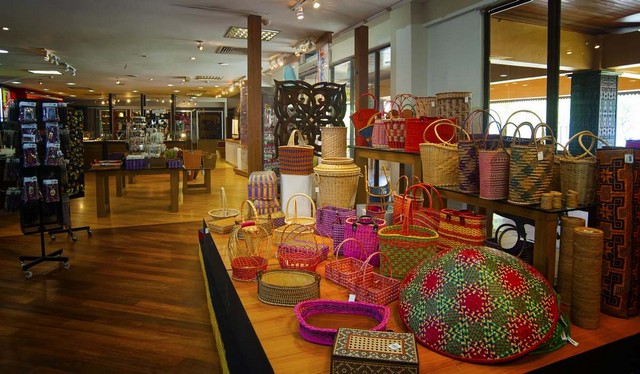For many people, crafts are seen as handicrafts for sale or on display at tourist destinations around the world.
These products are actually the end result of making full use of one’s ‘craft’, which refers to a skill that involves a high proficiency in ‘hands-on’ craftsmanship rather than the use of automated machinery to create practical, decorative or artistic objects.
It comes in various types, such as textile (weaving, embroidery, etc.); wood craft (wood-carving, lacquerware, etc.); paper craft (paper modelling, papier-mâché, etc.); pottery and glass crafts (earthenware; glass blowing, etc.); jewellery; and many others.

Different countries have different interpretations of crafts. In Malaysia, Act 222 of the Malaysian Handicraft Development Corporation Act 1979 defines a ‘handicraft product’ as:
“…any artistic product which is graced with cultural or traditional appeal and is the outcome of any process which is dependent solely or partly on manual skill, and includes any batik product; and “batik product” means any article, however produced, which bears a batik design on or at any part thereof.”
Crafts in Malaysia range from traditional to modern hand-made ones by craftspeople of diverse backgrounds, traditions and heritage, including ethnic craft, forest-based craft, metal, textile and pottery.

According to the Cultural Economy Development Agency (CENDANA), various stakeholders are playing their part in promoting and developing the country’s craft culture and industry.
Among them is the Malaysian Handicraft Development Corporation (MHDC) under the Ministry of Tourism, Arts and Culture, which organises large-scale events such as National Crafts Day and the Kuala Lumpur International Craft Festival.
In light of the COVID-19 pandemic, MHDC has launched online platforms for craftspeople to market their products globally and consumers from different parts of the world to purchase handicrafts directly, namely E-Craft Bazaar, Craft On The Go and MYCraftShoppe.

Local communities are also significant stakeholders in efforts to promoting crafts, with social enterprises including the Batik Boutique, Biji-Biji Initiative, Cotton and Sago and Tanoti actively championing the production of sustainable and ethical crafts through their collaboration with craftspeople.
The works of these people can be found at art bazaars that were first made popular by Art for Grabs in Kuala Lumpur; prominent ones are Gerai OA, Helping Hands Penan and Tamu-Tamu Collectives.

To preserve Malaysia’s traditional crafts, the Malaysian Government awards the title of Adiguru Kraf or Master Craftsperson to accomplished craftspeople for their achievements in their respective craft-fields.
They are selected based on their:
- High knowledge and skills in their crafts, with regards to their expertise in fine-workmanship, designing, embellishing and producing heritage craft of Malaysia
- Active and passionate engagement in restoring and preserving craft heritage
- Constant efforts in imparting knowledge and skills to apprentices and other craftspeople as future custodian of craft heritage; and
- Exceptional creativity and innovation in further developing and improving the quality of locally-inspired craft products.
As more Malaysians are doing their part in supporting the craft culture and industry in the country, it is important to recognise and be reminded of crafts’ importance in today’s digital-driven society.

They go beyond the handicrafts tourists tend to look for in souvenir shops and markets, and depending on who you ask, can be perceived for their universality, discipline, complexity, heritage and profundity.
Fundamentally, crafts oppose the notion of mass-production, allowing people to acknowledge and appreciate the value and aesthetics that come from handmade or distinctively designed items.
These items can add more character to an environment, transforming it into a place that is more visually pleasant and inspiring – for example, from a blank office space to a workplace that fosters productivity, or from a house to a comfortable home to live in.
“The fact is, living in a beautified environment with a certain amount of individuality and beautiful objects, adds immeasurably to our enjoyment of life.
“Crafts and craft skills are important contributors to this ideal, and for this reason alone are worth preserving,” states the Encyclopedia of Art.
Categories of Crafts in Malaysia
| CATEGORY | DESCRIPTION |
| Variety Craft | Various craft products based on beads, papers, shells, pearls and many others. E.g. pallet knife paintings, bunga roti, fabric paintings, pearl necklaces, beaded bags |
| Ethnic Craft | Craft products that are unique to an ethnic group. E.g. wood carvings, beaded items and woven products by natives of Peninsular Malaysia, Sabah and Sarawak |
| Forest-based Craft | Craft products based on materials found in forests, such as wood, bamboo and pandan by local craft entrepreneurs, as well as ethnic communities of Peninsular Malaysia, Sabah and Sarawak. E.g. furniture, baskets, bags |
| Ceramics | A craft that involve shaping and firing inorganic, non-metallic materials such as clay at high temperatures. Ceramic craft in Malaysia includes pottery, glass craft, marble craft and crystal craft. E.g. cups, bowls, plates, vases |
| Metal | Craft arts involving creating items out of silver, copper or iron for practical or decorative purposes. E.g. tepak sirih, weapons (keris, spear, etc.), jewellery (brooch, anklet, etc.) |
| Textile | A craft art that requires the use of plant, animal or synthetic fibres to create practical or decorative items. E.g. batik, songket, pua kumbu, keringkam |
Source: Malaysian Handicraft Development Corporation






